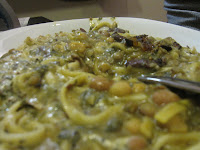
One of my favorite desserts, and conveniently vegan, is Shole Zard (literally translates into "loose yellow"): a saffron, rosewater-infused rice pudding. The flavors are delicious and distinctly Persian, embodying what I call the trinity of flavors. Shole Zard is a Persian delicacy commonly served during important days, a religious holiday, a cause for a family celebration or commemoration. This dish conjures nostalgic memories of endearing, extended family dinners , and my grandmother signaling the not-yet-end of dinner with the lovely surprise; always topped with intricate, artistic designs, dazzling in cinnamon, slivered blanched almonds, and pistachios.
Shole Zard has three main ingredients: rice, saffron, and rosewater. These ingredients are both integral to the region and found in numerous Persian specialties. The origins of the dessert are unknown (at least in a google search), but likely originated in the northern parts of Iran where rice was once more predominant while others parts of the country relied more on bread.
Rice is a staple in Persian cuisine, and traces its presence in the country back to the first century AD in Susa, where the grain was unearthed in an ancient grave. The grain was likely brought from Southeast Asia or India in ancient times.
The second ingredient, saffron, was cultivated in ancient Persia by the 10th century BC throughout the empire. Invaders and trading throughout Asia brought the golden threads to far western Europe and as far east as ancient China. The love affair with the world's most expensive food continues today as Iran is the world's largest producer of the aromatic spice.
And lastly, the third pairing in the trinity, rosewater or "golab," (also this blog's namesake) is the beautiful masterpiece of Persian cuisine. It is used heavily in most desserts, including pastries, ice cream, and of course, Shole Zard. Islamic historians indicate that Islamic chemists first introduced rosewater to the region for drinking and perfuming (Wikipedia). It is no surprise however, that Persians would infuse their sweet delicacies with the fragrant flower, and bring the sweet scents of spring to the dinner table.
Shole Zard incorporates the essentials of Persian ingredients to infuse a creamy, soul-warming dessert that appeals to tastebuds and senses alike. Take a lazy Saturday afternoon, turn on your favorite Persian old school album, and get stirring. I promise the results are well worth the effort!
This isn't the best image, and so better pictures will follow soon!
Shole Zard
Ingredients:
1 cup basmati rice
1 cup evaporated cane sugar
¼ cup canola oil
½ cup rose water
2 teaspoons ground saffron diluted in 2+ tablespoons warm water
3/4 cup slivered almonds
For garnish:
2 tablespoons slivered almonds
2 tablespoons ground pistachios
1 tablespoon ground cinnamon
Directions:
1) Wash 1 cup of short grain rice. Rinse and drain the rice several times until the water runs clear. Add the rice to a large, heavy-bottomed saucepan.
2) Add 7-8 cups of water into the pot of rice and partially cover with a lid. Bring the rice to a boil over medium heat, occasionally skimming the foam off the top.
3) Once your rice is soft and boiling (approximately 30 minutes), add 1 cup of sugar and stir gently to dissolve. Add an additional 2 cups of water and 1/4 cup canola oil, and stir to combine. Keep the rice partially covered and continue to cook over a medium-low heat for approximately 20 more minutes. Stir occasionally.
4) Add ½ cup of rose water, and 2 teaspoons of dissolved ground saffron threads. Pour this into the rice and stir thoroughly to combine (and watch all the flavors dance with one another!) Continue to cook, partially-covered, for another 20 minutes over low heat.
5) Remove the lid and stir well. The mixture should start to look like a thick pudding-like cream; all the water should be boiled out at this point. Add 3/4 cup slivered almonds.
6) Pour the mixture into serving dish(es) and refrigerate until shole zard solidifies.
7) Garnish with cinnamon, more slivered almonds, and sliced pistachios. Serve warm or cold.

















